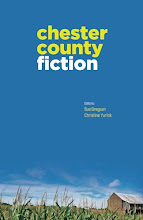In Part One, we
covered the importance of having several different selections ready to read, in
order to appeal to your audience. Now
we'll examine the physical aspects of your reading.
There's always a
temptation to read straight out of a copy of your book. Don't do it.
It's much easier to hold a few sheets of manuscript than an entire book. Furthermore, you should make notes and
changes to your piece, and there's little room to do that in a book.
Print out your
selection, preferably on white or ivory cover stock. Actual paper can blow away if there's a
breeze. Yes, you're inside...but a stiff
breeze can scatter unsecured paper when someone opens the door to enter. If you don't want to use cover stock on your
home printer, print it on plain paper and take it to a photocopy shop. Have them transfer it to the cover stock –
their photocopy process will probably be better, anyway. Your home printer may use water-soluble ink.
Of course,
number your pages. If they do get mixed
up, you want to be able to quickly get them in the correct order.
At the top, I
include the word count, and include a note as to how long it should take me to read this
piece. If I only have five minutes to read, I don't want to select a piece that takes ten minutes.
Assuming the piece has already been published, I include the information as to where it was published. If there's a website link, I add that.
Underneath that
is my “key” - my guide to the different characters. I put it in color, like so:
Waldo - blue
Victor – green
Bartender – black/boldface
Pirate Queen – red
When
I read, I'm going to do different voices for each character, and the different
colors remind me which character is which.
(Yellow doesn't show up well, so I
print black in a different typeface
instead.) If I wanted, I could add a
vocal characteristic, like “gruff,” “strong,” or “fearful.”
In the top
center, I put the title of the piece, followed by my name. No, I don't think I'll forget my name, but I
might lose the manuscript. If my name is
on it, it might get returned to me. But
the current title is something I MIGHT forget, so it's good to have it on the
page. (I often change titles, so they're
not fixed in my mind.)
The type is
double-spaced, of course. And, because
you can't guarantee that the lighting will be good at a lectern, I bump up the
point size from my standard 12 point to 14 point.
In the body of
the manuscript, I add diacritical marks to remind me of what I want to do. If I want to emphasize a point, I put it in
ALL CAPS. I add a slash /
where I want to pause.
(Technically, it's called a bar,
but I've never heard anyone call it anything but a slash.) A long pause gets
two slashes, like so: //. And, since eye contact is important, type LOOK UP to remind myself that I want to to look up at the audience at that
point. The LOOK UP note also keeps me from losing
my place when I go back to looking at the page.
I pick a spot with just a few words (easy to remember). After all, I'm not just looking up at the
audience - I'm also continuing to speak.
The punch line of a joke is perfect for this.
Then I put all
the dialogue in the appropriate color, and delete most of the
attributions. You don't need me to say,
“Victor said” when I'm doing Victor's voice.
Finally, I look
at the text. Are there any words I might
stumble upon when I read? Or words that
might be obvious to a reader but can be confusing when heard? (Homonyms, like whine and wine, for
example.) If there are any in the text,
I change them.
Remember, you're
there to entertain the audience – not confuse them. You didn't take an oath that the version
you're reading is identical to the one they would purchase. Deliver the best reading you can, even if you
have to make minor changes to the text.
And, like any other art form, you must practice, practice,
practice! Read the piece out loud, timing
yourself.
Thanks for
reading this blog post. I hope it has
been of help to you. Please comment
below – do you agree or disagree with the points raised? And feel free to comment on your own
experiences.



